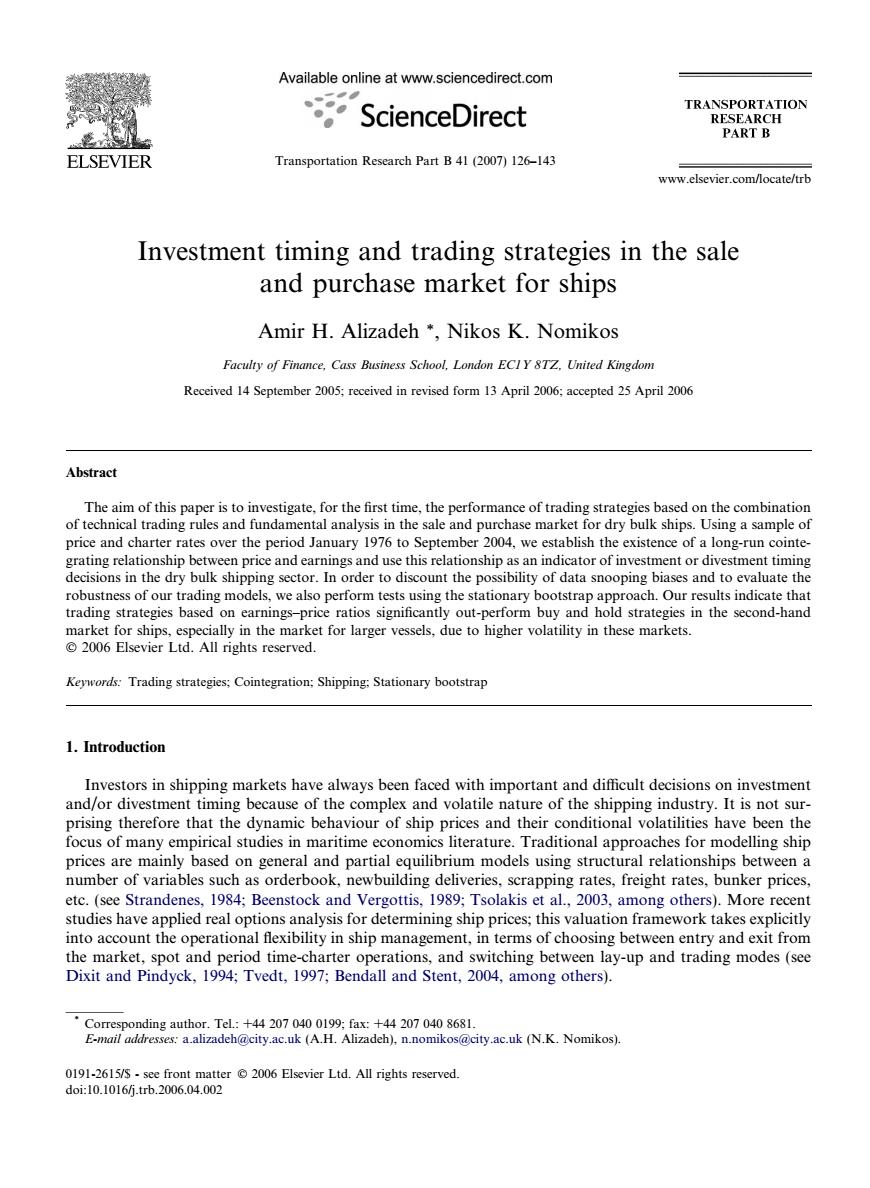正在加载图片...

Available online at www.sciencedirect.com ScienceDirect TRANSPORTATION RESEARCH PART B ELSEVIER Transportation Research Part B 41(2007)126-143 www.elsevier.com/locate/trb Investment timing and trading strategies in the sale and purchase market for ships Amir H.Alizadeh *Nikos K.Nomikos Faculty of Finance,Cass Business School,London ECIY 8TZ.United Kingdom Received 14 September 2005:received in revised form 13 April 2006:accepted 25 April 2006 Abstract The aim of this paper is to investigate,for the first time,the performance of trading strategies based on the combination of technical trading rules and fundamental analysis in the sale and purchase market for dry bulk ships.Using a sample of price and charter rates over the period January 1976 to September 2004,we establish the existence of a long-run cointe- grating relationship between price and earnings and use this relationship as an indicator of investment or divestment timing decisions in the dry bulk shipping sector.In order to discount the possibility of data snooping biases and to evaluate the robustness of our trading models,we also perform tests using the stationary bootstrap approach.Our results indicate that trading strategies based on earnings-price ratios significantly out-perform buy and hold strategies in the second-hand market for ships,especially in the market for larger vessels,due to higher volatility in these markets. 2006 Elsevier Ltd.All rights reserved. Keywords:Trading strategies;Cointegration;Shipping;Stationary bootstrap 1.Introduction Investors in shipping markets have always been faced with important and difficult decisions on investment and/or divestment timing because of the complex and volatile nature of the shipping industry.It is not sur- prising therefore that the dynamic behaviour of ship prices and their conditional volatilities have been the focus of many empirical studies in maritime economics literature.Traditional approaches for modelling ship prices are mainly based on general and partial equilibrium models using structural relationships between a number of variables such as orderbook,newbuilding deliveries,scrapping rates,freight rates,bunker prices, etc.(see Strandenes,1984;Beenstock and Vergottis,1989;Tsolakis et al.,2003,among others).More recent studies have applied real options analysis for determining ship prices;this valuation framework takes explicitly into account the operational flexibility in ship management,in terms of choosing between entry and exit from the market,spot and period time-charter operations,and switching between lay-up and trading modes(see Dixit and Pindyck,1994;Tvedt,1997;Bendall and Stent,2004,among others). Corresponding author.Tel.:+44 207 040 0199;fax:+44 207 040 8681. E-mail addresses:a.alizadeh@city.ac.uk(A.H.Alizadeh),n.nomikos@city.ac.uk (N.K.Nomikos). 0191-2615/S-see front matter 2006 Elsevier Ltd.All rights reserved. doi:10.1016j.trb.2006.04.002Investment timing and trading strategies in the sale and purchase market for ships Amir H. Alizadeh *, Nikos K. Nomikos Faculty of Finance, Cass Business School, London EC1Y 8TZ, United Kingdom Received 14 September 2005; received in revised form 13 April 2006; accepted 25 April 2006 Abstract The aim of this paper is to investigate, for the first time, the performance of trading strategies based on the combination of technical trading rules and fundamental analysis in the sale and purchase market for dry bulk ships. Using a sample of price and charter rates over the period January 1976 to September 2004, we establish the existence of a long-run cointegrating relationship between price and earnings and use this relationship as an indicator of investment or divestment timing decisions in the dry bulk shipping sector. In order to discount the possibility of data snooping biases and to evaluate the robustness of our trading models, we also perform tests using the stationary bootstrap approach. Our results indicate that trading strategies based on earnings–price ratios significantly out-perform buy and hold strategies in the second-hand market for ships, especially in the market for larger vessels, due to higher volatility in these markets. 2006 Elsevier Ltd. All rights reserved. Keywords: Trading strategies; Cointegration; Shipping; Stationary bootstrap 1. Introduction Investors in shipping markets have always been faced with important and difficult decisions on investment and/or divestment timing because of the complex and volatile nature of the shipping industry. It is not surprising therefore that the dynamic behaviour of ship prices and their conditional volatilities have been the focus of many empirical studies in maritime economics literature. Traditional approaches for modelling ship prices are mainly based on general and partial equilibrium models using structural relationships between a number of variables such as orderbook, newbuilding deliveries, scrapping rates, freight rates, bunker prices, etc. (see Strandenes, 1984; Beenstock and Vergottis, 1989; Tsolakis et al., 2003, among others). More recent studies have applied real options analysis for determining ship prices; this valuation framework takes explicitly into account the operational flexibility in ship management, in terms of choosing between entry and exit from the market, spot and period time-charter operations, and switching between lay-up and trading modes (see Dixit and Pindyck, 1994; Tvedt, 1997; Bendall and Stent, 2004, among others). 0191-2615/$ - see front matter 2006 Elsevier Ltd. All rights reserved. doi:10.1016/j.trb.2006.04.002 * Corresponding author. Tel.: +44 207 040 0199; fax: +44 207 040 8681. E-mail addresses: a.alizadeh@city.ac.uk (A.H. Alizadeh), n.nomikos@city.ac.uk (N.K. Nomikos). Transportation Research Part B 41 (2007) 126–143 www.elsevier.com/locate/trb��